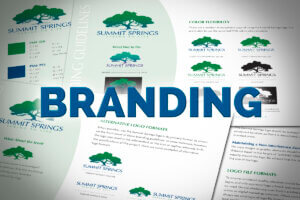 Think of your brand as a person. The logo is the face, the colors are the wardrobe, the fonts are the voice, and the messaging is the personality. Just like a person becomes familiar through consistency, a brand becomes recognizable when all its parts work together in harmony.
Think of your brand as a person. The logo is the face, the colors are the wardrobe, the fonts are the voice, and the messaging is the personality. Just like a person becomes familiar through consistency, a brand becomes recognizable when all its parts work together in harmony.
That harmony? It doesn’t happen by accident.
It’s the result of branding guidelines – the behind-the-scenes system that defines how your brand looks, sounds, and feels in every context.
Whether you’re a startup looking to build credibility or an established business ready to scale, branding guidelines are not a nice-to-have. They’re a must.
Let’s break down what goes into a strong brand guide, why it matters, and how you can put it to work.
What Are Branding Guidelines?
Branding guidelines (also known as brand standards or a brand style guide) are a documented set of rules that outline how your brand should be represented – visually, verbally, and emotionally.
These rules act as a reference point for designers, marketers, content writers, sales teams, and anyone else who touches your brand. Whether it’s your internal team or outside vendors, brand guidelines help ensure that everyone is rowing in the same direction.
Why Are Branding Guidelines Important?
Without guidelines, your brand runs the risk of becoming inconsistent – visually fragmented, tonally all over the place, and ultimately forgettable.
Here’s what a solid brand guide brings to the table:
- Consistency across platforms – Your website, social media, email marketing, packaging, signage – all speaking the same visual and verbal language.
- Faster onboarding – New team members or freelancers can get up to speed quickly without reinventing the wheel.
- Professionalism – Cohesive branding signals credibility, polish, and attention to detail.
- Brand recognition – Consistent use of logos, fonts, and colors helps people remember you.
- Efficiency – No more guesswork or “Do we use this logo here?” moments.
Bonus: A brand guide can support your SEO and content marketing strategy, too. When you define your tone, messaging pillars, and keywords, you’re also laying the foundation for on-brand, optimized copywriting across blog posts, landing pages, and digital campaigns.
What’s Included in Branding Guidelines?
While the scope can vary depending on your business, a comprehensive brand guide typically includes the following:
1. Logo Usage
- Primary logo, secondary versions, and icons
- Proper spacing and sizing
- Color variations (full-color, black-and-white, reversed-out)
- Incorrect usage examples (e.g., don’t stretch or rotate)
Pro Tip: Link to your logo assets folder so collaborators can access the correct files easily.
2. Color Palette
- Primary brand colors with hex, RGB, CMYK, and Pantone codes
- Secondary/accent colors
- Usage examples and contrast rules
This keeps your colors consistent across web, print, and promotional materials (which is especially important when you’re working with multiple vendors). Also, make sure you use a quality printer like Sabre Print Solutions.
3. Typography
- Primary and secondary fonts (with web-safe alternatives)
- Font hierarchy: headlines, subheads, body copy, etc.
- Usage instructions (when to bold, capitalize, or italicize)
When your typography is consistent, everything from pitch decks to blog graphics feels part of the same brand family.
4. Imagery and Photography
- Mood, tone, and subject matter for brand photography
- Examples of acceptable vs. off-brand images
- Filters, overlays, or treatments to apply
For example, if your brand leans modern and minimal, your visuals shouldn’t be overly cluttered or dated. Consistent imagery creates a visual shorthand for your brand’s personality.
5. Tone of Voice & Messaging
- Brand personality (Are you playful? Authoritative? Approachable?)
- Writing do’s and don’ts
- Sample taglines, mission statement, and boilerplate copy
- SEO keywords to weave throughout your content
Pro Tip: Include approved SEO phrases for high-value pages like your homepage, services, and blog posts. This will keep your copy on-brand and search-friendly.
6. Applications & Use Cases
- Examples of how your brand comes to life: business cards, social posts, email signatures, signage, packaging, ads, and more.
- Guidance for digital vs. print media
Need signage that aligns with your brand? Your print vendor should have clear specs, too – especially if you’re working on things like large format printing or specialty marketing collateral.
Who Should Use Your Branding Guidelines?
In short: everyone who interacts with your brand.
This includes:
- Graphic designers
- Web developers
- Marketing agencies
- Freelancers and contractors
- Advertising managers
- Sales teams
- Content writers
- Social media managers
- Print vendors
- Internal staff who build decks or proposals
A good brand guide isn’t meant to sit in a dusty PDF folder. It should be shared widely – and updated regularly as your business evolves.
How to Create (or Refresh) Your Brand Guidelines
If you don’t have guidelines yet, start small. Even a 5-page document covering your logo, colors, and fonts is better than nothing. You can build on it over time.
Here’s a simple process to get going:
- Audit your current brand assets – What logos, fonts, and colors are already in use? What’s working? What’s not?
- Define your brand personality and goals – This helps shape tone and visual direction.
- Create visual and verbal standards – Logo files, color codes, font choices, tone of voice, and messaging pillars.
- Compile it into a shareable guide – PDF, Google Slides, or an online portal (like Notion or Frontify) works well.
- Educate your team – Walk people through it. Make it easy to access and refer to.
- Update as needed – Revisit the guide yearly or when you evolve your offerings, visuals, or strategy.
If your brand has grown messy or inconsistent over time (it happens!), it might be time for a refresh. Working with a design and branding partner can help unify your look, sharpen your messaging, and reestablish your presence across all platforms.
Final Thoughts: Your Brand Deserves Clarity
 Your brand isn’t just a logo – it’s a promise. And that promise should feel clear, cohesive, and confident every time someone interacts with you.
Your brand isn’t just a logo – it’s a promise. And that promise should feel clear, cohesive, and confident every time someone interacts with you.
Branding guidelines take the guesswork out of presenting your business to the world. They turn your vision into a scalable system – one that keeps your identity strong and your communications seamless.
If you’re ready to refresh your brand identity or finally get those guidelines on paper, reach out to a creative agency (like Sabre Digital Marketing) that can help you align every pixel and word to your purpose.
Need help creating branding guidelines?
Let’s talk. We’ve helped businesses across retail, healthcare, municipal services, and nonprofits develop standout identities that scale beautifully across digital and print.

